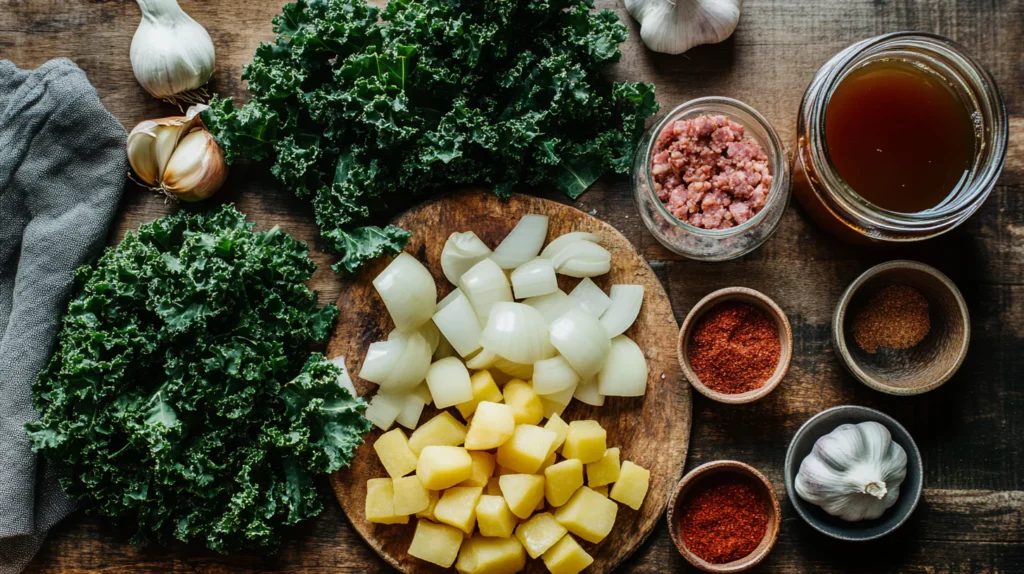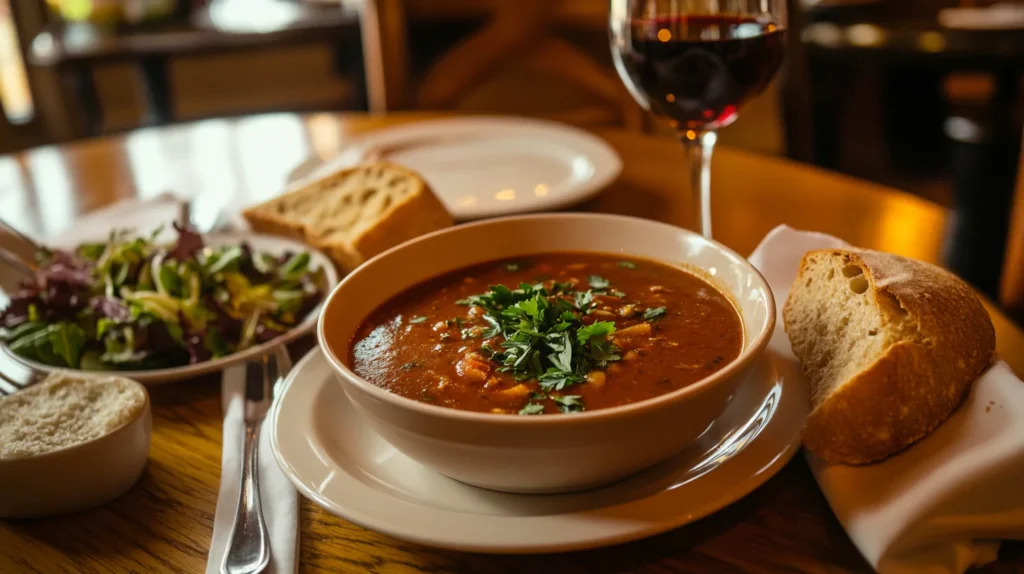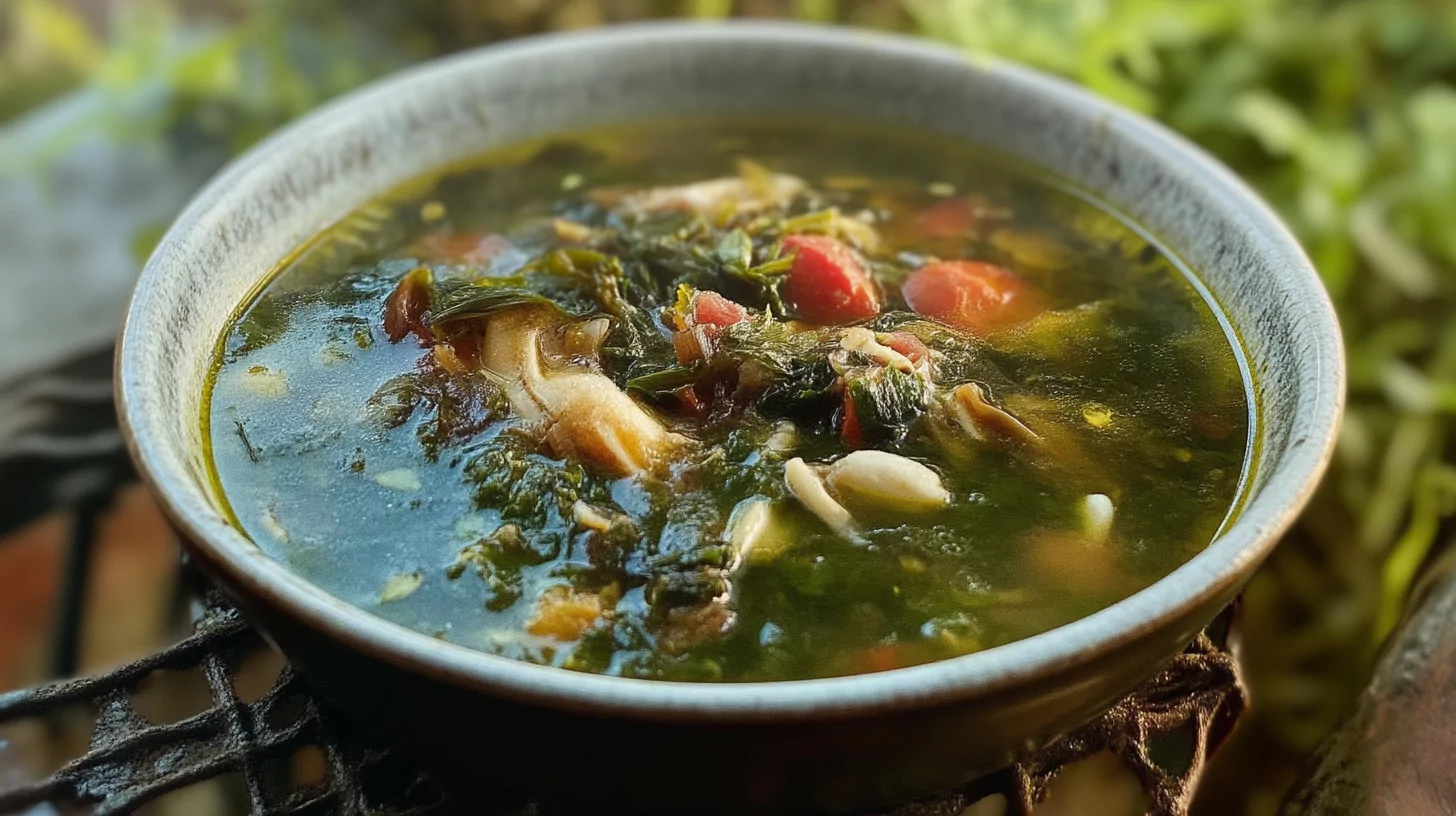Swamp soup recipe enthusiasts know this dish is the ultimate blend of hearty, nutritious, and flavorful ingredients. Originating in Southern kitchens, swamp soup combines leafy greens like kale or collard greens with savory broth, potatoes, and optional proteins to create a satisfying meal. Whether you’re looking for a comforting dinner or a unique addition to your meal rotation, this swamp soup recipe is easy to prepare and customizable for any dietary preference.
Ingredients for Swamp Soup Recipe
Swamp soup shines because of its adaptability. While traditional recipes feature greens and a savory broth, you can easily tweak it to fit your pantry or preferences. Below is a list of essential and optional ingredients to get you started.

Essential Ingredients for a Perfect Swamp Soup Recipe
- Leafy Greens (4-5 cups, chopped): Kale, spinach, or collard greens form the base of the soup.
- Onion (1 medium, diced): Adds depth and a sweet, savory flavor.
- Garlic (3 cloves, minced): Enhances the taste with its robust aroma.
- Chicken or Vegetable Broth (6 cups): Provides a flavorful foundation for the soup.
- Protein (optional, 1-2 cups): Smoked sausage, shredded chicken, or beans like cannellini or black-eyed peas.
- Potatoes (2 large, diced): For heartiness and texture.
- Olive Oil or Butter (2 tablespoons): For sautéing the aromatics.
- Seasonings: Salt, black pepper, red pepper flakes, thyme, and bay leaves for a well-rounded taste.
Optional Add-Ins to Customize Your Swamp Soup
- Carrots and Celery (1 cup each, diced): Adds a layer of sweetness and crunch.
- Tomatoes (1 cup, diced or canned): For tanginess and a vibrant color.
- Lemon Juice or Vinegar (1 tablespoon): Brightens the flavors.
- Parmesan Cheese (grated): For garnish and an umami kick.
- Cream or Coconut Milk (½ cup): For a creamy texture.
- Rice or Pasta (1 cup, cooked): To make the soup even more filling.
Dietary Modifications
- For a vegetarian version, replace meat with beans or lentils and use vegetable broth.
- For a low-carb option, skip the potatoes and add extra greens or zucchini.
- To make it gluten-free, ensure the broth and any seasonings you use are certified gluten-free.
Preparation Steps for Swamp Soup Recipe
Making swamp soup is a straightforward process. With some basic prep work, you’ll have a warm, comforting meal ready in no time.
How to Prepare Ingredients for Swamp Soup
- Wash and chop the leafy greens thoroughly.
- Dice the onions, garlic, and any optional vegetables.
- If using protein like sausage or chicken, slice or shred it as needed.
Sauté Aromatics
- Heat olive oil or butter in a large pot over medium heat.
- Add onions and cook until softened, about 5 minutes.
- Stir in garlic and cook for another minute until fragrant.
Build the Flavor Base
- Add diced potatoes and any optional vegetables like carrots or celery.
- Pour in the broth and season with salt, pepper, thyme, red pepper flakes, and bay leaves.
- Bring to a boil, then reduce to a simmer.
Add Protein and Greens
- If using pre-cooked sausage or chicken, add it now to infuse the soup with their flavors.
- Stir in the chopped greens and simmer until tender, about 10-15 minutes.
Final Touches
- Taste the soup and adjust seasonings as needed.
- For added creaminess, stir in cream or coconut milk during the last few minutes.
- Remove bay leaves before serving.
Customization and Variations of Swamp Soup Recipe
Swamp soup’s versatility allows you to tailor it to your taste preferences or dietary needs. Here are some creative variations and customization options to make the dish uniquely yours.
Adding More Greens
While kale, spinach, or collard greens are the classic choices, you can expand the flavor and nutrition profile by adding:
- Swiss Chard: Mild and tender, perfect for a lighter flavor.
- Mustard Greens: For a slightly spicy kick.
- Dandelion Greens: Earthy and slightly bitter for a rustic taste.
Protein Alternatives
If you want to experiment with protein options, try the following:
- Seafood Twist: Shrimp or white fish chunks (like cod) can be added for a coastal flair.
- Vegetarian-Friendly: Use tofu cubes or tempeh for a plant-based alternative.
- Hearty Beans: Black-eyed peas, lentils, or chickpeas for protein-rich vegetarian options.
Regional Variations
Swamp soup’s flavors can be tweaked to reflect different cuisines:
- Southern Style: Use smoked sausage, collard greens, and black-eyed peas.
- Italian-Inspired: Add cannellini beans, tomatoes, and a sprinkle of oregano.
- Asian Fusion: Replace broth with miso soup base and use bok choy as the greens.
Spice and Seasoning Adjustments
For a bolder or milder flavor, adjust the spice level to suit your preference:
- Spicy Version: Add cayenne pepper, hot sauce, or diced jalapeños.
- Herbaceous Notes: Increase the amount of thyme, rosemary, or parsley for a fragrant aroma.
- Citrus Boost: A splash of lime or lemon juice can brighten the soup’s flavor profile.
Texture Modifications
Want to tweak the soup’s texture? Consider these options:
- Creamy Swamp Soup: Blend a portion of the soup and mix it back in for a thick, velvety consistency.
- Chunky and Hearty: Leave all ingredients in their original form for a rustic, chunky texture.
- Brothy and Light: Reduce the potatoes or skip them altogether for a more broth-forward version.
Serving Suggestions for Swamp Soup Recipe
Swamp soup is a meal in itself, but pairing it with complementary sides or garnishes can elevate your dining experience.

Garnishes
- Crusty Bread: A slice of sourdough or cornbread is perfect for dipping.
- Grated Cheese: Parmesan or cheddar sprinkled on top enhances the soup’s flavor.
- Fresh Herbs: Chopped parsley, cilantro, or green onions for a burst of freshness.
Sides
- Salads: A crisp garden salad with a light vinaigrette complements the richness of the soup.
- Rice or Quinoa: Serve the soup over a bed of grains for a filling meal.
- Roasted Vegetables: Oven-roasted carrots or sweet potatoes add a sweet, caramelized contrast.
Beverages
Pair your swamp soup with drinks that match its earthy, hearty flavors:
- Wine: A medium-bodied red like Merlot or a crisp white like Sauvignon Blanc.
- Beer: A light lager or a spiced ale works wonderfully.
- Non-Alcoholic Options: Iced tea, sparkling water with a citrus twist, or apple cider.
Tips for Garnishing and Serving Swamp Soup Recipe
- Use wide, shallow bowls to showcase the soup’s vibrant greens and hearty ingredients.
- Add a dash of chili oil or a drizzle of olive oil for a gourmet touch.
- Serve hot with an extra wedge of lemon on the side for individual flavor adjustments.
Nutritional Benefits of Swamp Soup Recipe
Swamp soup isn’t just delicious—it’s packed with nutrients that contribute to a healthy diet. Each ingredient offers unique health benefits, making this dish a powerhouse of nourishment.
Rich in Vitamins and Minerals
The leafy greens used in swamp soup, such as kale, spinach, or collard greens, are nutritional superstars.
- Kale and Spinach: High in vitamins A, C, and K, which support vision, immune health, and bone strength.
- Collard Greens: Packed with calcium, magnesium, and antioxidants that combat oxidative stress.
The additional vegetables like carrots, celery, and potatoes contribute essential nutrients such as potassium, fiber, and beta-carotene.
Protein Power
If you include protein options like chicken, sausage, beans, or seafood, swamp soup becomes a protein-rich meal that:
- Supports muscle repair and growth.
- Keeps you full longer, aiding in weight management.
- Provides essential amino acids needed for overall body function.
High in Fiber
With the combination of greens, beans, and optional starchy vegetables like potatoes, swamp soup delivers a generous dose of dietary fiber. Fiber benefits include:
- Improving digestion and promoting gut health.
- Regulating blood sugar levels.
- Reducing bad cholesterol, contributing to heart health.
Low in Calories but Filling
Swamp soup is naturally low in calories, especially in its vegetarian form. Despite being light, the combination of nutrient-dense ingredients keeps you feeling satisfied.
Antioxidant Boost
The soup’s ingredients, including greens, garlic, and tomatoes, are loaded with antioxidants. These compounds help:
- Protect cells from damage caused by free radicals.
- Reduce inflammation.
- Lower the risk of chronic diseases like heart disease and cancer.
Customizable for Specific Diets
Swamp soup can be easily adjusted to suit various dietary needs, ensuring everyone can enjoy its nutritional benefits:
- Keto-Friendly: Swap potatoes with cauliflower or zucchini for a low-carb option.
- Vegan and Vegetarian: Stick to vegetable broth and plant-based proteins for a nutrient-packed, meat-free meal.
- Gluten-Free: Naturally gluten-free when made with certified broth and seasonings.
FAQs About Swamp Soup Recipe
Can I Make Swamp Soup Ahead of Time?
Yes, swamp soup tastes even better the next day as the flavors have time to meld. Store it in an airtight container in the refrigerator for up to 4 days. Reheat on the stovetop or microwave, adding a splash of broth if needed.
Can I Freeze Swamp Soup?
Absolutely! Swamp soup freezes well. Let the soup cool completely, transfer it to freezer-safe containers, and freeze for up to 3 months. Thaw overnight in the fridge before reheating. Avoid freezing if you’ve added cream—stir it in after reheating for the best texture.
How Can I Make Swamp Soup Spicier?
To add heat, include ingredients like red pepper flakes, diced jalapeños, or a dash of your favorite hot sauce. Spicy sausage is another great option for an added kick.
What Can I Use Instead of Potatoes?
If you’re looking for alternatives to potatoes, consider:
- Sweet potatoes for a hint of sweetness.
- Cauliflower for a low-carb option.
- Turnips for a slightly peppery flavor.
Can I Use Frozen Greens?
Yes, frozen greens like kale or spinach work well in swamp soup. Add them directly to the pot during the last 5-10 minutes of cooking.
What Should I Do if My Soup Is Too Thick?
If the soup is too thick, simply add more broth or water to reach your desired consistency. Stir well and adjust the seasoning if needed.
Conclusion
Swamp soup is a culinary gem that brings together flavor, nutrition, and versatility in one comforting bowl. Its origins in Southern cooking lend it a hearty and soulful quality, while its adaptability makes it a favorite in kitchens worldwide. Whether you stick to the traditional recipe or explore variations to suit your tastes and dietary needs, swamp soup never fails to deliver.
For a flavorful pairing, consider serving it alongside something bold and tangy, like these Salt and Vinegar Wings. The zesty kick of the wings perfectly complements the rich, comforting broth, creating a satisfying meal that balances textures and flavors.
With its nutrient-rich ingredients and straightforward preparation, this dish is perfect for busy weeknights, cozy family dinners, or meal prep. Pair it with crusty bread, a refreshing salad, or a glass of your favorite beverage, and you have a meal that’s as satisfying as it is wholesome.


1 thought on “Swamp Soup Recipe: A Hearty and Nutritious Dish You’ll Love”